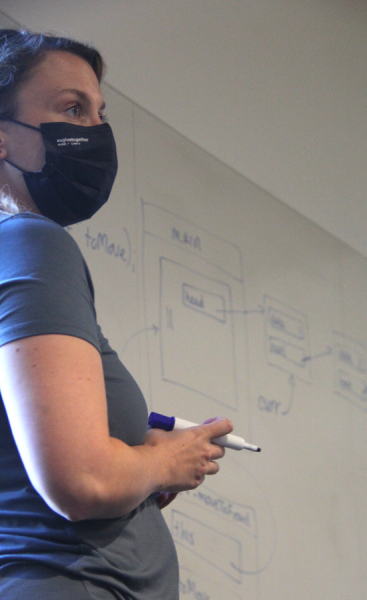DURHAM – It’s not exactly a magical portal connecting a country manor to the forest of Narnia, but the pass-through door between classrooms 126 and 130 in Duke Engineering’s Wilkinson Building has certainly allowed some interesting new things to happen this semester in ECE 551D: Programming, Data Structures, and Algorithms in C++.
ECE 551 is the introductory programming course that most first-year ECE master’s students take, and the newest cohort occupies both learning spaces, participating in a highly tailored educational experience that has come to be called “Flipped+.”
“The best approach to teaching and learning has never been for the professor to stand at the head of the room and lecture while the students take notes and try to memorize information,” said Duke ECE Professor of the Practice Andrew Hilton, who co-teaches the course with Professor of the Practice Genevieve Lipp. “In a flipped classroom, students consume the relevant information outside of class, then ask questions and get help during class time. We’ve been using that format for a while.”
But last year, Lipp and Hilton needed to adapt the flipped classroom model in order to offer the course online. They were concerned that students might not be able to raise questions effectively in an online format, so the instructors asked each student to submit a question in advance of every class. Teaching assistants organized the submitted questions by topic, and the instructors delivered mini-lectures in the main Zoom room to augment students’ understanding of tricky topics, while the TAs answered individual questions in breakout rooms.

Professor of the Practice Genevieve Lipp draws linked lists on the whiteboard of Wilkinson during a mini-lecture, while co-instructor Drew Hilton leads programming practice in the active learning space next door.
 The instructors thought the new format was a very effective evolution to flipped, and wanted to keep it this year—but doing so required a rather specific space. Fortunately, the new Wilkinson Building had been designed with two connected learning spaces that exactly fit the bill. Now, when Lipp and Hilton announce the mini-lecture topics at the beginning of class, there’s an initial shuffle between rooms as students decide whether to hear the mini-lecture or head next door to work on programming problems or seek additional help.
The instructors thought the new format was a very effective evolution to flipped, and wanted to keep it this year—but doing so required a rather specific space. Fortunately, the new Wilkinson Building had been designed with two connected learning spaces that exactly fit the bill. Now, when Lipp and Hilton announce the mini-lecture topics at the beginning of class, there’s an initial shuffle between rooms as students decide whether to hear the mini-lecture or head next door to work on programming problems or seek additional help.
“Our strategy has a lot in common with ‘just-in-time teaching,’” said Lipp. “In that model, the students consume some information and complete a quiz prior to class, and the results of the quiz determine the lecture topics. But we’re putting more of the onus on the students to proactively identify what they have questions about.”
If students constantly evaluate their own progress to figure out where the gaps in their understanding exist, said Lipp, the instructors can design educational experiences that are tailored to fill those gaps.
Flipped+ doesn’t change the fact that the class requires students to absorb and synthesize a huge body of programming concepts in a single semester, though. “The course is very fast paced, which makes it difficult to know if you fully understand a concept before the next set of concepts are brought on,” said first-year master’s student Amanda Breton, who said that though she enjoys the split classroom, she wishes that the course spanned two semesters instead of one.
“The course is crazy intense,” Hilton acknowledged. “But I think we’ve got a cool new thing going on in Pratt—I think we’ve found an interesting middle ground and a really interesting use of the new classroom space.”
(C) Duke University





























